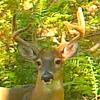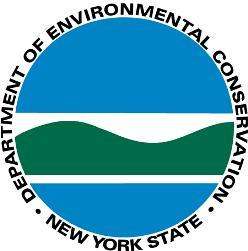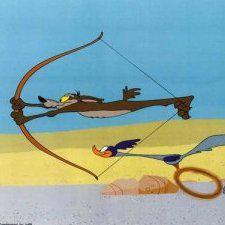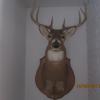
Statewide, we are anticipating deer harvests to be slightly lower in 2015 than in 2014, largely due to some deer mortality this past winter and resulting reductions in antlerless permits in parts of the state. The 2014/15 winter was more severe than average, with fairly prolonged periods of deep snow and sub-zero temperature, particularly in the western Catskills and southwestern New York, and was the second rough winter in a row in portions of northern New York. DEC staff observed numerous cases of fawn mortality and fielded many similar reports from the public in these areas during late winter and early spring.
In many Wildlife Management Units (WMUs) where winter was particularly harsh and where we would like to stabilize or increase deer populations, we reduced our target allocation of Deer Management Permits (DMPs; antlerless tags) by 20-30% from what was issued in 2014 to counter the impacts of winter deer mortality. However, deer populations in large portions of central New York, the Finger Lakes, Lake Ontario Plains and a few units in southeastern New York remain above desired levels, and we intend to issue similar or more DMPs to maintain harvest pressure on antlerless deer in these areas. Thus, on balance, about 3% fewer DMPs will be available statewide in 2015 than were issued in 2014.
New Antlerless Harvest Rules in several WMUs
New this fall, DEC has implemented several changes that affect hunters in parts of the state during the bow and muzzleloader seasons. In WMU 6A, despite no DMPs since 2011, antlerless harvests must be further curtailed to allow the deer population to grow toward desired levels. Because about half of the antlerless harvest in 6A currently occurs during the early muzzleloader season, DEC has adopted a rule to temporarily make the early muzzleloader season in this unit valid for antlered deer only. This change should sufficiently reduce the antlerless harvest to stimulate desired population growth while still allowing the minimal antlerless harvest that occurs during bow season and the late muzzleloader season.
In contrast, in WMUs 1C, 3M, 3S, 4J, 8A, 8C, 8F, 8G, 8H, 8N, 9A, and 9F, deer populations are above levels desired by local stakeholders, resulting in unacceptable impacts to residents and local ecosystems. In these units, offering increasing numbers of DMPs each year has no longer been a productive way of increasing antlerless take, yet greater antlerless deer harvests are needed. Harvest report data reveal that only 5.2% of successful hunters in these WMUs reported taking 3 or more deer (including bucks), and only 1.2% of successful hunters reported taking 4 or more deer. Additionally, reported harvests during the early bowhunting season in these WMUs are disproportionately skewed toward antlered bucks compared to other hunting seasons. Thus, DEC recently adopted a rule to redirect hunter effort toward antlerless deer by making the first 15 days of the early bowhunting season and all of the late bowhunting and late muzzleloader season in these units valid only for antlerless deer. Greater cooperation by bowhunters in removing antlerless deer in similar ratios as during other seasons and increased harvest of antlerless deer during the late seasons will benefit the broader public who are affected by negative deer-related impacts.
More information about these changes can be found at New Antlerless Hunting Rules for 2015.
Buck Harvest Management
DEC is also finalizing our analysis of potential buck hunting regulations to determine what approaches, if any, may be most appropriate considering hunter values in various regions of New York. Hunters continue to be much divided in what they value about buck hunting. While many hunters have voiced a desire to reduce harvest of yearling (1.5 year old) bucks to have a greater chance of taking an older buck with larger antlers, many hunters also prefer to have the freedom to choose which buck they harvest and to practice restraint voluntarily. Our process of sorting all this out is described in an article on pages 22-23 of the 2015-16 New York Hunting & Trapping Guideand at the Buck Harvest Management webpage. We anticipate completing the analysis and being ready to provide more information to hunters later this fall. Stay tuned!
In the meantime, many New York hunters have continued an encouraging trend by voluntarily choosing to pass young, small antlered bucks. As a result, the availability and harvest of older, larger antlered bucks has been increasing. It is clear that the choices hunters make matter. To see and take bigger bucks, I suggest hunters consider voluntary antler restrictions.
Help Protect NY Deer from Chronic Wasting Disease
Though we have found no new cases of Chronic Wasting Disease (CWD) in New York deer since 2005, DEC continues to take the threat of CWD very seriously. Hunters should too. CWD is always fatal to deer. If introduced, CWD could spread rapidly and will be practically impossible to eliminate from the wild deer herd once established. Preventing CWD from entering New York is the most effective disease management strategy. Hunters can help protect New York's deer herd from CWD by following these tips:
Do not use deer urine-based lures or attractant scents.
If you hunt outside of New York, debone or quarter your deer before bringing it back, and follow the law about importing carcasses or carcass parts from outside of New York. See CWD Regulations for Hunters.
Dispose of carcass waste in a landfill, not just out on the landscape.
Report any deer that appears sick or acting abnormally.
Hunt only wild deer and support fair chase hunting principles.
Checkout the full article here: http://www.dec.ny.gov/outdoor/37304.html
- Read more...
- 0 comments
- 3696 views









